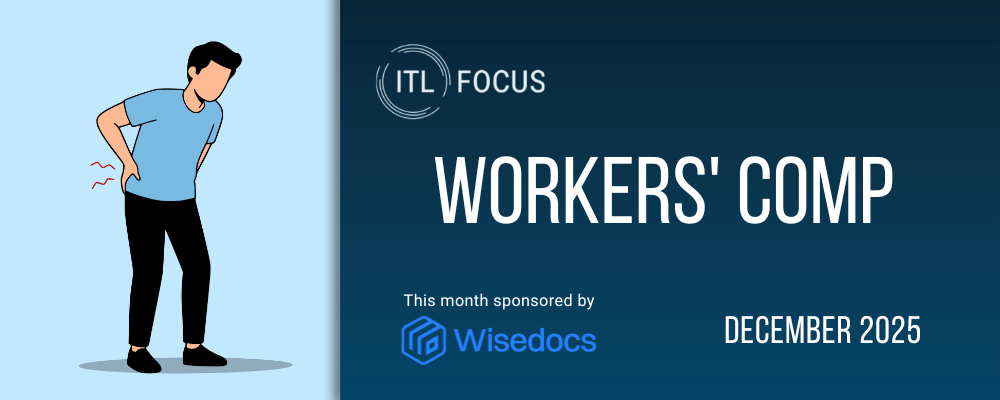When an employee is hurt on the job, returning to work often involves more than just healing the underlying physical injury. Depending on the diagnosis and other factors, a workplace event can lead to or exacerbate mental health diagnoses such as anxiety and depression, which often extend recovery time. It’s worth discussing the role case managers play in identifying and addressing underlying behavioral health symptoms to keep claims on track.
There’s no doubt that addressing mental health is beneficial for both employees and their employers. Every $1 spent toward helping employees manage anxiety and depression results in $4 in employee productivity and reduced health claims, according to a World Health Organization study. Studies reveal the likelihood of injured employees being treated for depression is 45% greater than those who are not injured. In addition, people injured at work are more likely to become depressed than those hurt outside of work.
But even when mental health services are available in the workplace, few employees know how or where to access them. According to the Society for Human Resource Management, only one in 10 employees are aware of benefits they can access via their employee assistance program (EAP).
Stress vs Distress
Mental health’s impact on claims typically plays out when an injured employee does not meet his or her return to work (RTW) goals. The claim management team becomes frustrated because the individual had no history of mental health issues, and injury and comorbidities were factored into the risk assessment score, part of the predictive modeling tools case managers use to determine recovery time.
But an individual may nevertheless face fear and anxiety as a result of an injury, and that may extend to everyday events that were more manageable prior to injury, but post-injury now feel insurmountable. This is more than “stress.” It is “distress,” a form of stress that can lead to depression, confusion, poor concentration, anxiety and poor performance. People react differently to distress, and reactions are dynamic, often determined by the context of the employee’s daily life.
Let’s take a look at two scenarios.
John is 27 years old, single and living by himself. One day, he slips on the stairs and takes a fall at the office that causes a fracture in his left leg. He is quickly treated and, after a short inpatient stay, is sent home in a cast. He’s still able to drive and attend all his therapy and doctor’s appointments and has support from his parents and girlfriend, who live nearby. His medical team is astonished by his quick recovery, and he’s back on the job even earlier than expected.
If we change the context, however, the situation changes quite a bit. Let’s say John is married with a toddler. His wife has recently become unemployed, and finances are tight. His mother is recovering from a stroke and, while she’s improving, is still unable to care for herself completely and relies on John and his wife to help her out. As a result, John misses several therapy and doctor’s appointments and, in addition to continued pain in his leg, is suffering from persistent headaches. Needless to say, John’s recovery is not matching his original projections, and he’s not ready to return to work.
Without knowing the life context, these two situations look identical. What’s missing in the analysis is the ability to predict which injured employees have life stressors that will affect their recovery and return to work.
See also: 5 Keys to a Low-Stress Work Environment in 2022
Identifying the Context; Easing Distress
Identifying these life stressors early can make a big difference in an individual’s recovery, and case managers, as well as other healthcare providers, are instrumental. A good place to start is by paying attention to physical symptoms that could indicate distress:
- Racing heart
- Insomnia
- Dizziness or shaking
- Elevated blood pressure
- Jaw clenching and muscle tension
- Stomach or digestive problems
Assessments and conversations should consider the whole person, not just the injury. The case manager may learn of a person’s financial and other personal stressors and suggest strategies and resources that can reduce and help manage the stress.
Sometimes, it can make an enormous difference if the case manager simply listens to injured employees’ concerns and validates them. Giving injured employees permission to voice their thoughts and feelings can help reduce anxiety and depression related to isolation, boosting their ability to get back on track. People are sometimes embarrassed to ask for help. Case managers can ensure the injured individual receives the resources he or she needs to address these concerns. They can also integrate these factors into the RTW plan to offer more realistic goals based on their circumstances, helping individuals feel less frustrated and more dedicated to their recovery.
See also: 3 New Trends in Life and Health
LASER Focus
At Genex, we use an approach we call LASER:
- L -Locating resistance that the employee might have to return to work
- A - Actively listening for verbal and non-verbal cues that might help guide the employee
- S - Selectively reinforcing the language the employee uses that indicates that they are ready for a positive change
- E- Empowering the employee to pursue the positive change, and
- R - Removing barriers that still exist to achieve that positive change
Most injuries and disabilities don’t keep people from doing what they love to do. LASER provides case managers with tools to help determine, with the affected employee, how to move forward.
But whether you formalize a strategy or simply work to understand the full situation for an employee, mental health is a real factor that needs to be considered. Sometimes, the context makes all the difference when it comes to returning to work.






